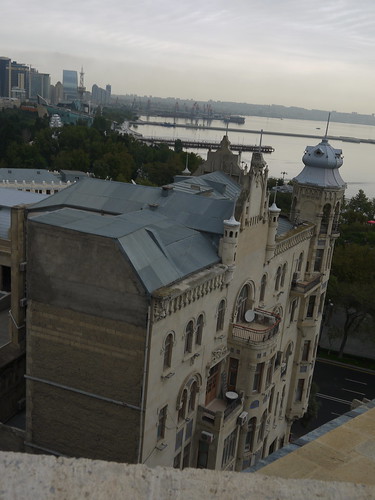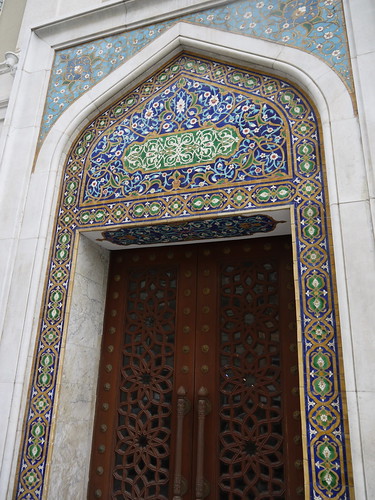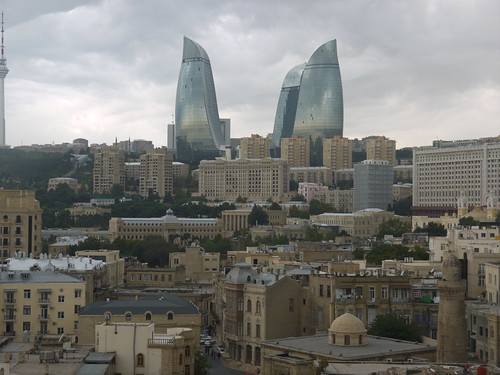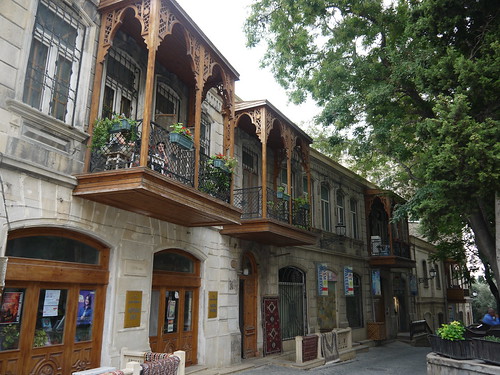Baku is an oil town. It has twice benefited from oil booms that have impacted on and redefined the way the city looks. The first boom came at the end of the 19th and beginning of the 20th centuries, the proceeds of which helped finance some extremely striking private residences collectively known as the "oil baron's mansions". My favourite is the Hajinksi Mansion (pictured below), which has a view of Baku's bay, enabling today's occupants to keep an eye on the current oil boom, as they can see the platforms from their front windows!
The house, completed in 1912, was built for Isa Bey Hajinski, a wealthy land owner, who discovered oil on his property. It has five storeys and was once one of the city's tallest buildings. It also sports limestone carvings on the facade together with a number of very attractive decorative elements. There are fantastic views of the house from the top of the nearby Maiden's Tower in the old city. Hajinski died before the Bolsheviks took power and his three sons fled to the west following the revolution. During the Soviet period the house was divided into several apartments and in 1944 General de Gaulle stayed here on his way from Tehran to Moscow where he had an appointment with Stalin.

Another wonderful building from this period, also with an interesting story is the Muktarov Palace, built in neo-Gothic style, also in 1912. It was designed by the Polish architect Josef Plosko and was a gift from oil baron Murtaza Mukhtarov to his non-Muslim Ossetian born wife, Lisa Tuganov. Legend has it that on a trip to France they saw a beautiful Gothic building which inspired Lisa to say that whoever lived there must be happy. Taking the hint Mukhtarov had an exact replica produced in Baku before taking his wife there in a carriage and announcing it was hers!
Unlike Hajinksi, Mukhtarov lived to see the arrival of the Bolsheviks - although not for very long. Following the revolution of 1917, part of the house was occupied by the organisation of "Liberated Turkic Women" but the family also remained in residence. When the Bolsheviks came to Azerbaijan in 1920, Mukhtarov resisted giving up ownership and when soldiers came to commandeer the house, he shot three of them before turning the gun on himself and committing suicide. The building is now used to register marriages.
The Mammadov residence is in the heart of the old city. Completed in just one year, 1908-9 and designed by architect Nikolai Georgiyevich Bayev, it was restored by the Mobil company in 1996, working from old drawings and photographs since many of the original features and furnishings had been destroyed or stolen. Less externally ornate than either the Hajinski or Mukhtarov residences, the Mammadov house has a beautiful enclosed wooden balcony, in keeping with the traditional Azeri style houses in the old city. I understand the interior has a grand staircase with superb murals on either side. Mammadov himself escaped the Bolsheviks to Poland and then disappeared. The house went through the usual routine of being subdivided into flats but only after serving as government offices and as a nursery.
Also worth a look is the superb building that houses the Nizami Museum of Azerbaijani Literature, situated on the edge of the central Fountain Square (a vast public space which attracts thousands of visitors every day and upon which several important streets converge) and is just a stone's throw away from the old city. This building started life in 1850 as a single storey caravanserai before passing to the Metropol Hotel in 1915 when a second story was added. It assumed its current purpose in 1939 (although it did not open its doors as a museum until 1945). The exterior features a number of statues of great Azeri writers and has a striking white and blue contrast design whilst one of the side entrances has retained a brightly coloured "oriental" feature around the doorway (pictured below). The ground floor has a book shop that stocks books in English as well as Azeri and Russian.

Following the collapse of the Soviet Union at the beginning of the 1990's, Baku became capital of a newly independent Azerbaijan and after some extremely difficult initial years, the city is enjoying a boom period. New buildings are going up everywhere, some mere pastiches of neo-classical buildings whilst others are frighteningly close to Soviet style architecture at its worst. However, there are also many stunning examples of new architecture, not least the "Flames" (pictured below) - three enormous towers that loom over the city and can be seen from just about everywhere. Not yet occupied, one will be the local branch of the Fairmont Hotel, another an office and business complex and the third a government building. At night, the "Flames" are lit (!) electronically and show a series of graphics including the waiving of the Azerbaijani flag and a yellow and red burning effect.

There are many other new structures - the soon to be opened Heydar Aliyev Cultural Centre designed by Zaha Hadid (although the roof is already being replaced due to a fire) and the Crystal Hall which hosted this year's Eurovision Song Contest. This oil financed building boom is one of the main reasons that Baku is now sometimes referred to as the Dubai of the Black Sea. I've never been, so I couldn't comment. Its not on my list.
Speaking of books, I read the Azeri classic - Ali and Nino, by Kurban Said, before coming to Baku. It is a fast moving, episodic and extremely readable story about the romance between Ali, an Azeri Muslim and Nino, a young woman from a notable Georgian, Christian family. It makes several references to the politics of the time - the story is set at the beginning of the 20th century and includes Azerbaijan's very brief period of independence in 1920. It also mentions the Shirvanshah Palace in the old city and a number of other well known sites. The identity of the author is a bit of a mystery, with several theories about his real identity. Less of a mystery is the success of the book shop that shares the name of the novel. There are two branches - one just off Fountain Square and another on the busy pedestrianised Nizami Street. The chain also has a small but cosy, period furnished cafe of the same name which is decorated with scenes from the book. It too is also just off Fountain Square.
I recently discovered the wonderful music of jazz pianist Vigaf Mustafa-Zadeh. He fused jazz with mugham - a local traditional musical form which is also popular in Iraq and other parts of the Middle East. Vigaf was at the height of his creativity during the Soviet years. Jazz was considered to be western and somewhat decadent and he was viewed with suspicion by the Soviet authorities.
The old city of Baku is home to a small but fascinating house museum to his memory. Tucked away in a very narrow, and apparently un-named alley of the Icheri Sheher (old city), the house is marked with a small plaque to tell intrepid travellers that this is where the maestro once lived. Yasine, my excellent guide, is extremely knowledgeable about the old city but even he hadn't been before and had to ask several locals before we found someone who knew the museum. I was very grateful that he persevered. We were shown up the stairs by a slightly nervous, but smiling museum keeper who proceeded to tell us about Vagif's life, drawing our attention to the exhibits with the help of a Soviet style pointer!
The exhibition is housed in three rooms of what was a shared apartment and acted as home to three families. The walls are covered in photographs of the musician's family, including his mother who had a musical background and his two daughters - Aziza who is also a jazz performer and daughter of his second wife, whilst Lala is an award winning classical musician and daughter of his first wife. There are some posters advertising his concerts, a haunting painting of Vagif which dominates the second room of the exhibition and most charmingly, his little mono record player and some of his record collection. Its a small museum, but well worth a visit and you can even buy a CD of his recording before you leave. And of course, I bought it. My favourite piece of his is Baku Night - you can hear it by clicking on the link below.
Incidentally, Yasine also helped me find some other CDs that I wanted - collections by Azeri greats, Rubabe Muradova and Shovket Alekbarova. Thanks for all of your help Yasine - including in researching the oil baron's houses!
The Icheri Shehar has many other attractions. Deemed to be a World Heritage Site by UNESCO, it is now protected and therefore secure from inappropriate development. The Shirvanshah's Palace was commissioned by Sheikh Ibrahim I in the 15th century. The attractive courtyard (pictured below) at the entry leads to an initial gallery with a map of the Shirvanshah empire and a family tree, establishing context for the visitor. The palace houses a collection of artefacts from the times of the Shirvanshahs as well as a very simple, but starkly beautiful private mosque and burial place of a Sufi mystic - Seyid Yahya Bakuvi, who worked as a tutor to the Shirvanshah children. The palace is arranged on two levels - the upper being closed when I visited.

The Maiden's Tower, Baku's most distinctive landmark (perhaps until the arrival of the Flames?), overlooks the Caspian Sea which once reached its walls. The current tower dates from the 12th century, but there is general disagreement over its origins. Visitors can climb to the very top to view the city, look out across the Caspian and see the oil platforms and best of all for me to get a really good view of the Hajinski house. The climb to the top is quite demanding up a narrow, circular and steep set of stairs. Is it worth the climb? Definitely, but take it slowly and mind your head - the ceiling is quite low at some points! At the time of my visit the tower was being cleaned and was wrapped in scaffolding, so no pictures this time I'm afraid.
Yasine told me one of the many stories attached to the Tower. An invading army was about to take the city when its leader offered to turn back his troops if the ruler would hand his daughter to him in marriage. In order to save the city and his subjects, he reluctantly agreed and his daughter was married to the invader. She set one condition - that she be allowed to dance on the roof of the tower at her wedding. Her wish granted, she promptly threw herself to her death, having fulfilled her promise of marriage. The invaders withdrew and never returned to the city. This story would make a good opera - the romance of it!
The Icheri Shehar is also home to many other historical monuments - a hamam, two caravanserai, the ruins of an early Christian church, a number of mosques and a set of museums. But best of all is simply strolling the streets, exploring the narrow alleys and being taken by surprise at each new delight as you turn another corner. Once again, I think another visit is on the cards!

The house, completed in 1912, was built for Isa Bey Hajinski, a wealthy land owner, who discovered oil on his property. It has five storeys and was once one of the city's tallest buildings. It also sports limestone carvings on the facade together with a number of very attractive decorative elements. There are fantastic views of the house from the top of the nearby Maiden's Tower in the old city. Hajinski died before the Bolsheviks took power and his three sons fled to the west following the revolution. During the Soviet period the house was divided into several apartments and in 1944 General de Gaulle stayed here on his way from Tehran to Moscow where he had an appointment with Stalin.

Another wonderful building from this period, also with an interesting story is the Muktarov Palace, built in neo-Gothic style, also in 1912. It was designed by the Polish architect Josef Plosko and was a gift from oil baron Murtaza Mukhtarov to his non-Muslim Ossetian born wife, Lisa Tuganov. Legend has it that on a trip to France they saw a beautiful Gothic building which inspired Lisa to say that whoever lived there must be happy. Taking the hint Mukhtarov had an exact replica produced in Baku before taking his wife there in a carriage and announcing it was hers!
Unlike Hajinksi, Mukhtarov lived to see the arrival of the Bolsheviks - although not for very long. Following the revolution of 1917, part of the house was occupied by the organisation of "Liberated Turkic Women" but the family also remained in residence. When the Bolsheviks came to Azerbaijan in 1920, Mukhtarov resisted giving up ownership and when soldiers came to commandeer the house, he shot three of them before turning the gun on himself and committing suicide. The building is now used to register marriages.
The Mammadov residence is in the heart of the old city. Completed in just one year, 1908-9 and designed by architect Nikolai Georgiyevich Bayev, it was restored by the Mobil company in 1996, working from old drawings and photographs since many of the original features and furnishings had been destroyed or stolen. Less externally ornate than either the Hajinski or Mukhtarov residences, the Mammadov house has a beautiful enclosed wooden balcony, in keeping with the traditional Azeri style houses in the old city. I understand the interior has a grand staircase with superb murals on either side. Mammadov himself escaped the Bolsheviks to Poland and then disappeared. The house went through the usual routine of being subdivided into flats but only after serving as government offices and as a nursery.
Also worth a look is the superb building that houses the Nizami Museum of Azerbaijani Literature, situated on the edge of the central Fountain Square (a vast public space which attracts thousands of visitors every day and upon which several important streets converge) and is just a stone's throw away from the old city. This building started life in 1850 as a single storey caravanserai before passing to the Metropol Hotel in 1915 when a second story was added. It assumed its current purpose in 1939 (although it did not open its doors as a museum until 1945). The exterior features a number of statues of great Azeri writers and has a striking white and blue contrast design whilst one of the side entrances has retained a brightly coloured "oriental" feature around the doorway (pictured below). The ground floor has a book shop that stocks books in English as well as Azeri and Russian.

Following the collapse of the Soviet Union at the beginning of the 1990's, Baku became capital of a newly independent Azerbaijan and after some extremely difficult initial years, the city is enjoying a boom period. New buildings are going up everywhere, some mere pastiches of neo-classical buildings whilst others are frighteningly close to Soviet style architecture at its worst. However, there are also many stunning examples of new architecture, not least the "Flames" (pictured below) - three enormous towers that loom over the city and can be seen from just about everywhere. Not yet occupied, one will be the local branch of the Fairmont Hotel, another an office and business complex and the third a government building. At night, the "Flames" are lit (!) electronically and show a series of graphics including the waiving of the Azerbaijani flag and a yellow and red burning effect.

There are many other new structures - the soon to be opened Heydar Aliyev Cultural Centre designed by Zaha Hadid (although the roof is already being replaced due to a fire) and the Crystal Hall which hosted this year's Eurovision Song Contest. This oil financed building boom is one of the main reasons that Baku is now sometimes referred to as the Dubai of the Black Sea. I've never been, so I couldn't comment. Its not on my list.
Speaking of books, I read the Azeri classic - Ali and Nino, by Kurban Said, before coming to Baku. It is a fast moving, episodic and extremely readable story about the romance between Ali, an Azeri Muslim and Nino, a young woman from a notable Georgian, Christian family. It makes several references to the politics of the time - the story is set at the beginning of the 20th century and includes Azerbaijan's very brief period of independence in 1920. It also mentions the Shirvanshah Palace in the old city and a number of other well known sites. The identity of the author is a bit of a mystery, with several theories about his real identity. Less of a mystery is the success of the book shop that shares the name of the novel. There are two branches - one just off Fountain Square and another on the busy pedestrianised Nizami Street. The chain also has a small but cosy, period furnished cafe of the same name which is decorated with scenes from the book. It too is also just off Fountain Square.
I recently discovered the wonderful music of jazz pianist Vigaf Mustafa-Zadeh. He fused jazz with mugham - a local traditional musical form which is also popular in Iraq and other parts of the Middle East. Vigaf was at the height of his creativity during the Soviet years. Jazz was considered to be western and somewhat decadent and he was viewed with suspicion by the Soviet authorities.
The old city of Baku is home to a small but fascinating house museum to his memory. Tucked away in a very narrow, and apparently un-named alley of the Icheri Sheher (old city), the house is marked with a small plaque to tell intrepid travellers that this is where the maestro once lived. Yasine, my excellent guide, is extremely knowledgeable about the old city but even he hadn't been before and had to ask several locals before we found someone who knew the museum. I was very grateful that he persevered. We were shown up the stairs by a slightly nervous, but smiling museum keeper who proceeded to tell us about Vagif's life, drawing our attention to the exhibits with the help of a Soviet style pointer!
The exhibition is housed in three rooms of what was a shared apartment and acted as home to three families. The walls are covered in photographs of the musician's family, including his mother who had a musical background and his two daughters - Aziza who is also a jazz performer and daughter of his second wife, whilst Lala is an award winning classical musician and daughter of his first wife. There are some posters advertising his concerts, a haunting painting of Vagif which dominates the second room of the exhibition and most charmingly, his little mono record player and some of his record collection. Its a small museum, but well worth a visit and you can even buy a CD of his recording before you leave. And of course, I bought it. My favourite piece of his is Baku Night - you can hear it by clicking on the link below.
Incidentally, Yasine also helped me find some other CDs that I wanted - collections by Azeri greats, Rubabe Muradova and Shovket Alekbarova. Thanks for all of your help Yasine - including in researching the oil baron's houses!
The Icheri Shehar has many other attractions. Deemed to be a World Heritage Site by UNESCO, it is now protected and therefore secure from inappropriate development. The Shirvanshah's Palace was commissioned by Sheikh Ibrahim I in the 15th century. The attractive courtyard (pictured below) at the entry leads to an initial gallery with a map of the Shirvanshah empire and a family tree, establishing context for the visitor. The palace houses a collection of artefacts from the times of the Shirvanshahs as well as a very simple, but starkly beautiful private mosque and burial place of a Sufi mystic - Seyid Yahya Bakuvi, who worked as a tutor to the Shirvanshah children. The palace is arranged on two levels - the upper being closed when I visited.

The Maiden's Tower, Baku's most distinctive landmark (perhaps until the arrival of the Flames?), overlooks the Caspian Sea which once reached its walls. The current tower dates from the 12th century, but there is general disagreement over its origins. Visitors can climb to the very top to view the city, look out across the Caspian and see the oil platforms and best of all for me to get a really good view of the Hajinski house. The climb to the top is quite demanding up a narrow, circular and steep set of stairs. Is it worth the climb? Definitely, but take it slowly and mind your head - the ceiling is quite low at some points! At the time of my visit the tower was being cleaned and was wrapped in scaffolding, so no pictures this time I'm afraid.
Yasine told me one of the many stories attached to the Tower. An invading army was about to take the city when its leader offered to turn back his troops if the ruler would hand his daughter to him in marriage. In order to save the city and his subjects, he reluctantly agreed and his daughter was married to the invader. She set one condition - that she be allowed to dance on the roof of the tower at her wedding. Her wish granted, she promptly threw herself to her death, having fulfilled her promise of marriage. The invaders withdrew and never returned to the city. This story would make a good opera - the romance of it!
The Icheri Shehar is also home to many other historical monuments - a hamam, two caravanserai, the ruins of an early Christian church, a number of mosques and a set of museums. But best of all is simply strolling the streets, exploring the narrow alleys and being taken by surprise at each new delight as you turn another corner. Once again, I think another visit is on the cards!

No comments:
Post a Comment